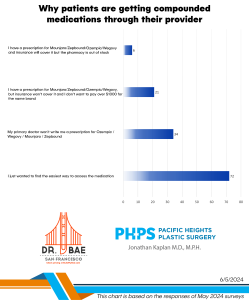
In a recent article in the Journal of Plastic and Reconstructive Surgery, there’s a discussion regarding the devastating, albeit very, very, very low risk of blindness after receiving fillers. Fillers can be any material that is injected under the skin of the face to fill in deep creases after a loss of volume associated with aging.
Most fillers such as Juvederm, Restylane, Radiesse or Belotero can be injected very safely by a trained plastic surgeon or dermatologist. However, in very rare cases, particularly in untrained hands, the filler material can get into a blood vessel under the skin that is connected to blood vessels around the eye and lead to blockage of the blood vessel, causing blindness. See image above. Again, it’s important to note that this is very uncommon. If it happens, it’s typically associated with injecting filler too close to a blood vessel in between the eyebrows or around the nose.
In fact, it’s so uncommon that “in 2012, in a European study, Lazzeri et al published the results of their search of the MEDLINE and Cochrane databases, Google and Google Scholar, Current Contents, and PubMed. They found 29 articles representing 32 cases of post–cosmetic filler vascular occlusion causing blindness.” That means that with a review of every known article on the subject, and with the millions of people receiving fillers every year, only 32 cases were found.
What filler was at greatest risk for blindness?
Surprisingly, the most common filler that could lead to blindness wasn’t even one of the fillers mentioned above. The biggest culprit was a patient’s own fat! During a facelift, it’s increasingly common to treat the patient’s aging face in two ways. Not only do you want to lift the facial tissues to their younger position, but one of the bigger causes of an older appearing face is loss of fat or volume. For this reason, fat is harvested from the abdomen or thighs and injected into the face in areas where fat has been lost. This restores a youthful appearance for which pulling and lifting can’t do alone.
So how do you avoid this problem. Seek out a plastic surgeon or dermatologist that is familiar with facial anatomy and has experience with fillers. While this doesn’t guarantee never having this complication, it does make a difference. Also, it’s important that the doctor inject the filler as they’re pulling the syringe out of the face rather than injecting while the needle is going into the face. The risk is also lower when using a very fine needle or even a blunt cannula to inject. This all results in a lower likelihood of injecting directly into a blood vessel accidentally.
Can you treat the blindness if it occurs?
If Juvederm, Belotero or Restylane is accidentally injected into a blood vessel, the quick injection of a compound called hyaluronidase can quickly dissolve the filler, possibly avoiding blindness. But this doesn’t always work so the best solution is avoidance of the problem in the first place!
Hopefully none of us (patient or physician) ever experiences this problem.
Click here for the original blog post written by Dr. Jonathan Kaplan for BuildMyBod.




